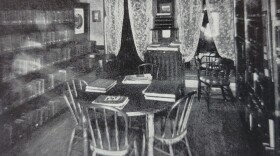There was a time when Boom Lake in Rhinelander wasn’t just a quiet, scenic waterway, it was a Northwoods’ racetrack. As Rhinelander’s sawmilling era declined, and the old log booms that gave the lake it's name were removed, Boom Lake gradually transformed from an artery of the lumber industry into a playground for aquatic recreation. Boat races were held on Boom Lake as early as the 1930’s, gained popularity during the 40s, and from the 1950s through the 1960s, those events grew into some of the most anticipated community spectacles of the summer.
Boom Lake, with its long, straight shoreline at Hodag Park offered excellent visibility for spectators. Thousands could gather along the banks and clearly see the oval race course marked with buoys stretching out in front of them. Bleachers were often set up, but many families simply brought their blankets and picnics, turning race days into daylong summer outings.
By the early-1950s, the Rhinelander Boat Club was the driving force behind organized regattas. The club was energetic, civic-minded, and determined to put Rhinelander on the powerboating map. Their efforts culminated in a series of American Power Boat Association, and the Wisconsin Motor Boat Association, sanctioned events that drew competitors from across the Midwest.
By 1958, the event had become known as the Rhinelander Regatta, and had matured into a well-organized, multi-class event. That year, more than 100 boats competed in categories ranging from stock utility classes to sleek hydroplanes, some nicknamed “pumpkin seeds” or “shells” by local enthusiasts. The fastest boats topped out at 70 miles per hour on the straightaways, making for dramatic finishes and white-knuckle, high spraying turns.
Every successful event in history takes people working hard to organize them. The people behind the scenes of the regatta were putting in even more effort than the racers on the water. Ray Church, a local business leader, served as chairman of the 1958 regatta and helped steer the event’s growth. Fellow Rhinelander resident Jack Priester handled setup and buoy placement at Hodag Park, and Wally Brosi, commander of the Wisconsin State Power Boat Association, provided officiating and structure. Bill Johnson of the Rhinelander Eagles was also instrumental in fundraising and sponsorships.
Of course, the drivers made headlines too. “Denny” Terzinski, a local favorite, gained regional fame after winning the Wisconsin State Class B Utility Championship in 1960. That same year, Jim Wagner, another Rhinelander competitor, earned a strong fourth-place finish in his class. Many of the racers built and maintained their boats themselves, outfitted with powerful engines.
By 1960, Boom Lake had achieved statewide recognition as a prime regatta venue. That summer, the National Guard NCO Club sponsored the Wisconsin State Championships on Boom Lake, drawing racers from Illinois, Minnesota, Michigan, and Iowa. More than a dozen state champions were in attendance, and the racing drew thousands of spectators.
These regattas were more than just races, they were full-blown community celebrations. Events were often held alongside Fourth of July festivities, complete with parades, fireworks, and water ski exhibitions.
The golden era of boat racing on Boom Lake was in the '50s and early '60s, but boat racing in some form continued into the 1970s and early 1980s. Smaller, locally organized races popped up during summer festivals and civic celebrations. But as insurance costs rose and environmental regulations tightened, the regattas faded. The community’s appetite for high-speed spectacle began to shift, and the roar of the outboards eventually ceased.
Today, Boom Lake is known more for pontoons, and quiet fishing mornings. But the echoes of high performance boat motors still linger in memory. The sight of waving starting flags, the spray of the water, the cheers from Hodag Park, and of boats flying across the water remain treasured moments for those who were there.
For those who still want to relive the glory days of racing on Boom Lake, several authentic hydroplane racing boats are on display at Duke’s Outboard Motor and Boat Museum at Pioneer Park Historical Complex in Rhinelander. These vintage boats, lovingly preserved, serve as a reminder of when Rhinelander’s waters thundered with speed and spirit.
Sources: Rhinelander Daily News 1930-78. First hand accounts from spectators and racers.









